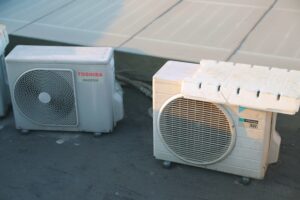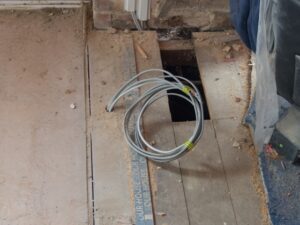Are you concerned about a basement flood or a potential sewage backup?
Well, you’re not alone!
Sewer line issues can be overwhelming, but the good news is that they can often be prevented with regular inspection and prompt repair. Imagine your peace of mind knowing that your plumbing system is working efficiently and there are no surprises waiting for you down the road.
When was the last time you thought about your sewer line?
It’s easy to forget about it, but sewer lines are critical to your home’s plumbing system. If problems arise, they can quickly escalate into expensive repairs and stress-inducing situations. Whether you’re dealing with slow drains, foul odors, or unexpected backups, addressing these issues early can save you time, money, and a whole lot of trouble.
At Excel Mechanical, we specialize in sewer line inspection and repair services for both residential and commercial properties. Our goal is simple: to keep your plumbing system running smoothly while offering reliable solutions that fit your needs and budget.
In this blog, we will talk about:
- Understanding sewer line systems and the common issues you may face
- The importance of regular inspections and choosing the right repair methods
- How Excel Mechanical ensures professional and reliable service for both homes and businesses
Let’s dive into why choosing the right team for your sewer line issues can make all the difference.
Understanding Sewer Line Systems
Sewer line systems are crucial in managing waste from homes and businesses. These systems transport water and waste from your property to a treatment facility. Understanding how they work can help you detect any potential issues early.
Components of Sewer Line Systems:
- Pipes: These carry waste from your property to the main sewer line. They are typically made of PVC or clay.
- Traps: Prevent sewer gases from entering your home.
- Cleanouts: Enable access to the system for inspection and cleaning.
Regular maintenance is essential to keep your sewer line system in good working order. Look for signs of blockages or leaks, such as slow drains or unusual odors. Addressing these issues early can prevent more significant problems later.
Sewer Line Inspection
Regular sewer line inspections help prevent unexpected repairs and water damage. Inspections can reveal issues like blockages, leaks, or tree root intrusions. Various techniques enhance the detection and diagnosis process, ensuring your plumbing system operates smoothly.
Visual Inspection Techniques
Visual inspection techniques are fundamental in checking the exterior condition of sewer lines.
Professionals survey the lines for any visible signs of damage, such as cracks or corrosion. Regular checks catch problems early, avoiding extensive repairs down the road.
Simple tools such as flashlights and inspection mirrors can make a big difference. This approach is cost-effective and widely used for initial assessments. If you notice suspicious conditions, contacting experts to evaluate the situation further is wise.
Our skilled technicians ensure precise diagnosis and effective solutions.
Camera Inspection Methods
Camera inspection involves using specialized cameras to explore the interior of sewer pipes. This method allows for detailed views of hidden areas, revealing problems like blockages, breaks, or misalignments.
High-resolution cameras are inserted into the pipes through cleanouts. Traveling through the system, they transmit live images to a monitor. This technique not only identifies issues but also helps determine their precise location.
Camera inspections reduce guesswork, enabling prompt and efficient repairs.
Identifying Common Issues
Several common issues can be identified during a sewer line inspection, such as blockages, leaks, or root intrusions. Blockages often occur due to accumulated debris or foreign objects obstructing the flow. Leaks may result from pipe cracks or joint failures, leading to water seepage.
Root intrusions happen when tree roots infiltrate sewer lines, causing damage and blockages. Prompt identification of these problems is essential to avoid severe damage. Early detection allows for the implementation of effective repair strategies, keeping repair costs manageable.
Regular inspections by trained professionals can significantly improve the functionality of your sewer system, helping you avoid inconvenience and expense in the future.
Approaches to Sewer Repair
When dealing with sewer line issues, knowing the different methods available for repair is essential. This guide outlines traditional approaches, innovative trenchless solutions, and pipe-bursting techniques, each serving unique needs and situations.
Traditional Repair Methods
Traditional sewer repair involves excavation to access and fix damaged pipes. This method requires digging a trench along the affected line to reach the problem area.
While effective, this approach can be disruptive, affecting landscaping and structures. However, it allows for completely replacing damaged sections, ensuring a thorough repair.
This method is often necessary for extensive damage or the pipes unsuitable for modern repair techniques. It can be a good choice for homeowners who prefer a direct solution despite the disruption.
Trenchless Repair Solutions
Trenchless repair solutions offer a less invasive alternative to traditional methods.
Two main techniques are common: pipe relining and pipe bursting.
With pipe relining, a resin-coated liner is inserted into the existing pipe and then inflated to create a new, durable inner layer. This method requires minimal digging and is ideal for pipes with minor cracks or leaks.
These techniques are popular because they are cost-effective and reduce restoration time. They are suitable for those wanting quick fixes without major property disruption. They are typically faster and more environmentally friendly.
Pipe Bursting Techniques
Pipe bursting is another trenchless method that involves breaking the old pipe and replacing it simultaneously with a new one. This method is optimal for severely damaged pipes or when upsizing is desired.
A bursting head is pulled through the old pipe, breaking it apart while pulling in a new pipe behind it. Pipe bursting requires two access pits but affects the surrounding area less than full excavation.
Excel Mechanical specializes in these modern approaches, ensuring you get the most efficient system tailored to your needs. With a focus on quality and value, our team ensures the job is done right, minimizing interruptions to your home or business.
Preventive Maintenance and Care
Maintaining your sewer line is essential to avoid costly repairs and ensure smooth operation. By setting a regular maintenance schedule, practicing effective drainage, and managing tree roots, you can extend the life of your sewer system and prevent unexpected problems.
Regular Maintenance Schedules
Regular inspections and cleanings of your sewer lines are vital.
Scheduling annual or bi-annual checks can help catch minor issues before they become major problems. Professionals can use cameras to inspect the lines for damage or blockages. This proactive approach helps identify issues like cracks or leaks early on.
Routine cleaning through methods like hydrojetting can also prevent buildup that might cause clogs.
Effective Drainage Practices
Good drainage practices keep your sewer lines in top shape.
- Drain screens should be used to prevent large debris from entering the pipes.
- Avoid pouring grease, oil, or coffee grounds down the drain, as they can cause buildup and blockages.
- Consider installing water-efficient fixtures to reduce the strain on the sewer lines.
- Regularly flushing the system with hot water can help eliminate minor blockages.
Tree Root Management
Tree roots can invade sewer lines, causing significant damage and blockages.
It’s essential to manage the vegetation around your home—plant trees at a safe distance from sewer lines to minimize the risk of root intrusion. If tree roots are a concern, regular inspections can help detect early signs of intrusion.
In some cases, root barriers or chemical root killers applied by professionals can prevent growth into the pipes.
Legal and Environmental Considerations
Understanding the legal and environmental factors involved in sewer line inspection and repair is important. Compliance with regulations, minimizing environmental impact and securing necessary permits ensure the process runs smoothly without legal hindrances.
Regulatory Compliance
Observing laws and standards is crucial in sewer line work. Regulations are set to protect public health and the environment. Thus, they must be followed carefully.
You should understand the legal requirements specific to your area. This includes standards for installation, repair techniques, and waste disposal methods.
Failures can result in fines or delays.
Environmental Impact Mitigation
Environmental protection is a key concern in sewer line projects.
You should be proactive in reducing potential harm to ecosystems and water resources. Techniques like trenchless technology can minimize ground disruption and reduce pollution. Proper waste handling and disposal prevent contamination in local waterways and soil.
By choosing effective methods like these, you ensure a minimal impact on the environment.
Permits and Local Codes
Securing permits is often mandatory before starting any sewer line work. These permits verify compliance with local building codes and are necessary to ensure that any alterations adhere to urban planning standards.
You should contact local authorities to understand the necessary documentation and fees involved. Each area has its own specific requirements. Ignoring these can lead to penalties or project halts. Familiarity with these procedures helps in planning and executing the work efficiently.
Working with professionals who understand these requirements is beneficial in avoiding complications.
Choosing a Service Provider
Finding the right service provider for sewer line inspection and repair is essential.
Look for companies with a strong reputation and positive reviews. Our experience in handling similar tasks should be considered. To ensure reliability, check our licenses and certifications. Good providers also offer insurance for their services. This protects you if something goes wrong during the inspection or repair.
Key Factors to Consider:
- Experience: Years in the business and expertise in sewer repairs.
- Certifications: Valid licenses and insured operations.
- Customer Reviews: Positive feedback from previous clients.
Excel Mechanical stands out because of its commitment to quality and value. We have a team of professionals skilled in HVAC and plumbing services, ready to cater to residential and commercial needs.
Why Choose Excel Mechanical?
- Quality Service: Aiming for exceptional results every time.
- Personalized Solutions: Systems tailored to your needs and budget.
- Experienced Professionals: Skilled experts in HVAC and plumbing.
When selecting a service provider, communication is essential. Good companies maintain clear and honest communication throughout the process. This ensures you understand each step of the sewer line inspection and repair.
Cost Factors and Budgeting
When planning for sewer line inspection and repair, several cost factors come into play.
- One major factor is the length of the sewer line. Longer lines often need more time and labor, which can increase costs.
- The type of materials used also impacts the budget. Some materials last longer but may cost more initially. It’s essential to weigh the long-term benefits against the upfront expense.
- Another factor is the extent of the damage. Minor issues may only need a simple fix, while major problems might require bigger repairs. Detecting issues early can save money.
- The location also affects costs. Urban areas might have higher labor costs than rural areas. Accessibility can add to expenses if the line is hard to reach.
Getting a detailed estimate is key to managing your budget. At Excel Mechanical, we provide clear, detailed quotes so you know what to expect. We aim to offer the best possible solutions for both residential and commercial clients.
Prices can vary depending on factors such as:
- Length of the sewer line
- Material types
- Damage extent
- Location and accessibility
Frequently Asked Questions
Sewer line inspection and repair can seem intimidating, but it doesn’t have to be. In fact, when you stay informed and proactive, you can ensure your plumbing system remains in top shape for years. So, what exactly should you be looking out for? And how do you ensure that you’re making the right choices when it comes to sewer line repairs?
Let’s dive into some of the most common questions homeowners and business owners have when it comes to sewer lines.
How much does a sewer line inspection typically cost?
A sewer line inspection usually costs between $100 and $400, but prices can vary depending on location and property size.
What are the signs that indicate the need for sewer line repair?
Watch for slow drains, foul odors, and water backups. Unusual patches of lush grass in your yard may also signal a problem.
How often should a residential sewer line be inspected?
You should inspect your sewer line every 1-2 years. Regular inspections help catch problems early and prevent costly repairs.
What does a sewer line repair process entail?
Sewer line repair often involves identifying the problem, accessing the damaged section, and fixing or replacing it. This process might require digging, especially if the pipe is difficult to reach.
What are the common methods for replacing a damaged sewer line?
Common methods include traditional trenching and trenchless techniques like pipe bursting or pipe lining. These options vary in cost and disruption to your property.
Can I get a sewer line inspection free of charge?
Free sewer line inspections are uncommon, but some companies may offer them with certain conditions. Always verify what’s included in any promotion.




